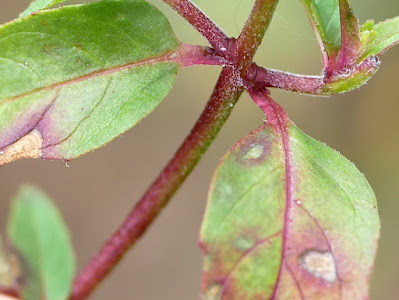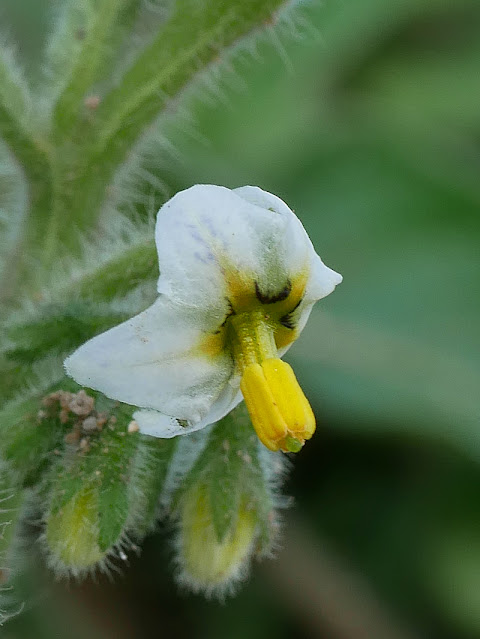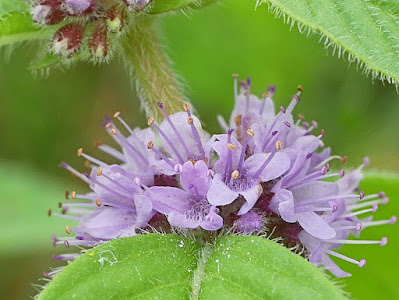Summer has drawn to a close and many plants are in seed or dying back, but there's always plenty of interesting things to see. Here is a selection of plant species I found in Cornwall from mid to the end of August.
Angelica is now in full bloom, a lover of wet areas.
Angelica sylvestris
Tutsan is mostly now full of berries with just a few of their bright yellow flowers to be seen now.
Hypericum androsaemum
A very attractive plant is Wavy-leaved St. John's-wort with its petals having scarlet streaks on them. It's more or less confined to Cornwall and parts of Devon, South and mid Wales.
Hypericum undulatum
Marsh Ragwort is also in full flower and dominates many woodland rides in Cornwall. It becomes much more uncommon the further east one goes in the UK. Note the very large terminal lobe on the leaves that other Ragworts lack.
Jacobaea aquatica
Greater Plantain has two subspecies : subspecies major and subspecies intermedia.
Subsp. major is the common one found almost everywhere, but below is subsp. intermedia which is often coastal, but can be found inland on poor soils, like it was here in a plantation woodland path.
Plantago major subsp. intermedia
Goldenrod is another late Summer flowering species and it adorns many road verges and woodland rides as here in a woodland near Wadebridge. It's also found in coastal areas where its form is generally small and compact.
Solidago virgaurea
A nice display of Goldenrod and Heather in a woodland ride.
Heath Speedwell still going strong, another species mostly found in woodland.
Veronica officinalis
What I thought was Lanceolate Spleenwort from a by-way Cornish hedge near Wadebridge. Much like Black Spleenwort without the black stem and with the fronds not being triangular in outline. However this may be a young Dryopteris species.
Purple Moor-grass is very common on heaths and bogs in the area, but I think this is the first time I've photographed its flowers. Lovely aren't they.
Molinea caerulea
You don't always need flowers to identify a species. These leaves belong to Pale Dog-Violet, an uncommon violet found on drier heaths in the region. The leaves are elongated and crenate around the edges.
Viola lactea
The next group of photos come from a Cornwall Botany Group field trip to the Perranuthnoe area in SW Cornwall.
Nettle-leaved Goosefoot from an arable field
Chenopodiastrum murale
A BSBI referee confirmed Pale Willowherb, one of the rarer Willowherbs from a damp fallow field. These have club stigmas, stalked leaves with cuneate bases with prominent veins, and pale flowers.
Epilobium roseum
Musk Storksbill growing in an arable field edge.
Erodium moschatum
Small-flowered Cranesbill from the same arable field.
Geranium columbinum
The lovely small flowers of Henbit Dead-nettle
Lamium amplexicaule
We found a small colony of gone to seed Thyme Broomrape, a veyr rare plant outside of The Lizard area.
Orobanche alba
A few remaining Autumn Squill in flower on coastal clifftops.
Scilla autumnalis
The best find of the day was Green Nightshade, not only new to me but a new species for Cornwall too.
Back to general recording and on a road verge near St Austell, I found another new species for me, Carthusian Pink. However, I believe it was sown when the road was made many years ago, evidenced by other species being present that were alien to Cornwall, such as Small Scabious and a continental type of Birdsfoot Trefoil.
An evening walk along a footpath between arable fields near Wadebridge produced some nice species such as this Striped Goosefoot. Other goosefoots were present too, including Fig-leaved and Red Goosefoot.
Chenopodium strictum subsp strictum
Many-seeded Goosefoot from the same area.
Lipandra polysperma
Black Bindweed is often overlooked as it flowers in late Summer and is often obscured by crops.
Fallopia convolvulus
Late Summer is also the time for Corn Mint, which has a musty mint smell and lacks flowers at the crown of the plant.
Mentha arvensis
Nearby were several Field Woundworts, a declining species in much of the UK.
Stachys arvensis
Fool's Parsley with its characteristic bracteoles hanging down vertically under the umbels. The seeds look pretty cool too.
Aethusa cynapium
Weld growing along a path between arable fields.
Reseda luteola
Finally, a Field Pansy brightening up a field corner.
Viola arvensis
As you can see, late Summer has plenty of species to offer and September will be the same. It isn't until the first frosts arrive that everything really slows down with many species slumbering over the Winter months. So make the most of it until then.
Take Care
Dave
















































